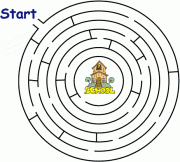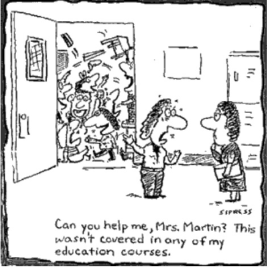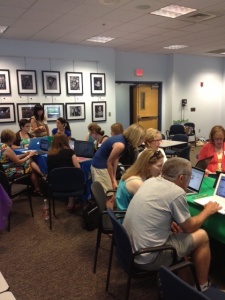I remember rewriting, ‘Miss Long,’ at least 6 times on the white board.
I remember hearing the bell ring and all of the middle schoolers outside reply with excitement filled, ‘Woo’s’.
I remember the pit in my stomach which was a perfect mix of anticipation and pure terror.
I remember watching the empty classroom fill with a sea of 12 & 13 year olds.
“This is my first class. I can’t believe it!!”
Fast forward, oh let’s say, about three weeks….
I remember turning my back to the class (in a pathetic attempt to write a vocabulary word on the board), clenching my jaw, fighting to hold back tears thinking, “You just have to make it through the rest of this class. You have 10 minutes. Don’t show them the tears.”
Some pep talk, huh?
That^ is the first year of teaching. Can you recall pieces of your first year yet?
So, let’s break it down. What are the most common stumbling blocks when it comes to the first year? I generated some common barriers with actionable solutions.
1. Not Knowing the Building
Teachers that are new often find their way to their classroom, the main office, and most likely the nearest bathroom. Knowing other logistics comes second…but should it?
How you can help support beginning teachers:
- Keep arms, legs, and gum to yourself while on the tour! Walk around the building with the beginning teacher. While meeting with a new teacher last year, I asked a question about her student’s reading levels…that question led into, ‘Let’s head over to the guidance office and print them out’…which led into, ‘Let’s go find the guidance office!’
- What is important to know in the faculty hand book? What do the those ‘codes’ mean? What should you do if a student has been absent all week? It’s crucial to front-load this information – or – at least let the beginning teacher know where they can find the information.
2. Classroom Management
This is a tough one for all teachers, but especially newbies.
“A 2004 Public Agenda survey found that 85 percent of teachers believed ‘new teachers are particularly unprepared for dealing with behavior problems in their classrooms’ (p. 3). A separate survey of 500 teachers found that teachers with three years or fewer on the job were more than twice as likely as teachers with more experience (19 percent versus 7 percent) to say that student behavior was a problem in their classrooms (Melnick & Meister, 2008; Goodwin, 2012).”
If behavior isn’t under control, let’s face it, little learning is going to take place.
How you can help support beginning teachers:
- Actively listen! Admitting there are behavioral or managerial issues isn’t easy to do, so new teachers need supporters in their corner. Compassion is key…we’ve all been there.
- And, on that same thought, judgmental, ‘I don’t have that problem with him’ & ‘You need to have rules’ are not only like sticking a dagger into their self-esteem, but they also aren’t too helpful. Try offering some ideas or encouraging the teacher to check out what you do in your classroom. New teachers are N-E-W and don’t have a bag full of tricks yet – help them collect some!
- Offer to check out their classroom and talk about procedures together. Is there a system for collecting homework? Late work? What do students do upon entering the classroom? Taking a classroom walk-through may prove to be helpful.
3. Becoming an Island
Teaching can be a lonely place when classroom doors are closed. A study by Scholastic and the Gates Foundation found that teachers spend about 3% of their teaching day collaborating with colleagues. 3%?!
How you can help support beginning teachers:
- Pop in their classroom – or better yet – take them out of their classroom. Introduce them to other teachers/educators in the building. Help them build up a mini-network… or at least be able to recognize some familiar faces.
- Set up a time to observe each other… or invite them into your classroom. Grab coffee and discuss afterwards.
- Mention a committee or group that they could join. It may seem a little overwhelming to the new teacher at first, but reassure them they can take on as much/little responsibility as they’d like at first. It’s a great way to network with other individuals in school – and keeps them abreast on current school events.
4. Curriculum I-dunnos
Pacing guides and state standards are helpful. However, not knowing instructional techniques, common student misconceptions associated with the content, where to locate resources, etc., etc., etc. can quickly leave new teachers overwhelmed.
How you can help support beginning teachers:
- Plan together. Share some resources or sticky situations that commonly come up while teaching (insert subject or topic here). It’s so important that we, as educators, are always reflective – why not share that process with the beginning teacher?
- A common phrase in schools is: ‘don’t recreate the wheel’… So why are we expecting this of new teachers? Quite honestly, we need to have a sense of urgency when supporting beginning teachers – we can’t wait 3 years for them to figure it out on their own. That decision will impact many students.
- Question and discuss grading. What works? What doesn’t? What have you learned? How could students take accountability for their learning and self-assess? What are the goals of the assessment? How will you use student data to drive and inform practice?
Summing It Up
I’ve been able to relive many of the woes and triumphs vicariously though beginning teachers as their Coach. One of my colleagues tweeted this a few months ago and it still resonates with me:
As we embark on another new school year (yes, I realize it’s still early August), I find it critical that we, as more seasoned educators, truly reach out to the new teachers in our buildings. After all, schools should be welcoming places for students and teachers alike.
Here’s a chart that depicts the road new teachers travel their 1st year:
To learn more about the ‘first year curve’ check out The New Teacher Center’s article.







